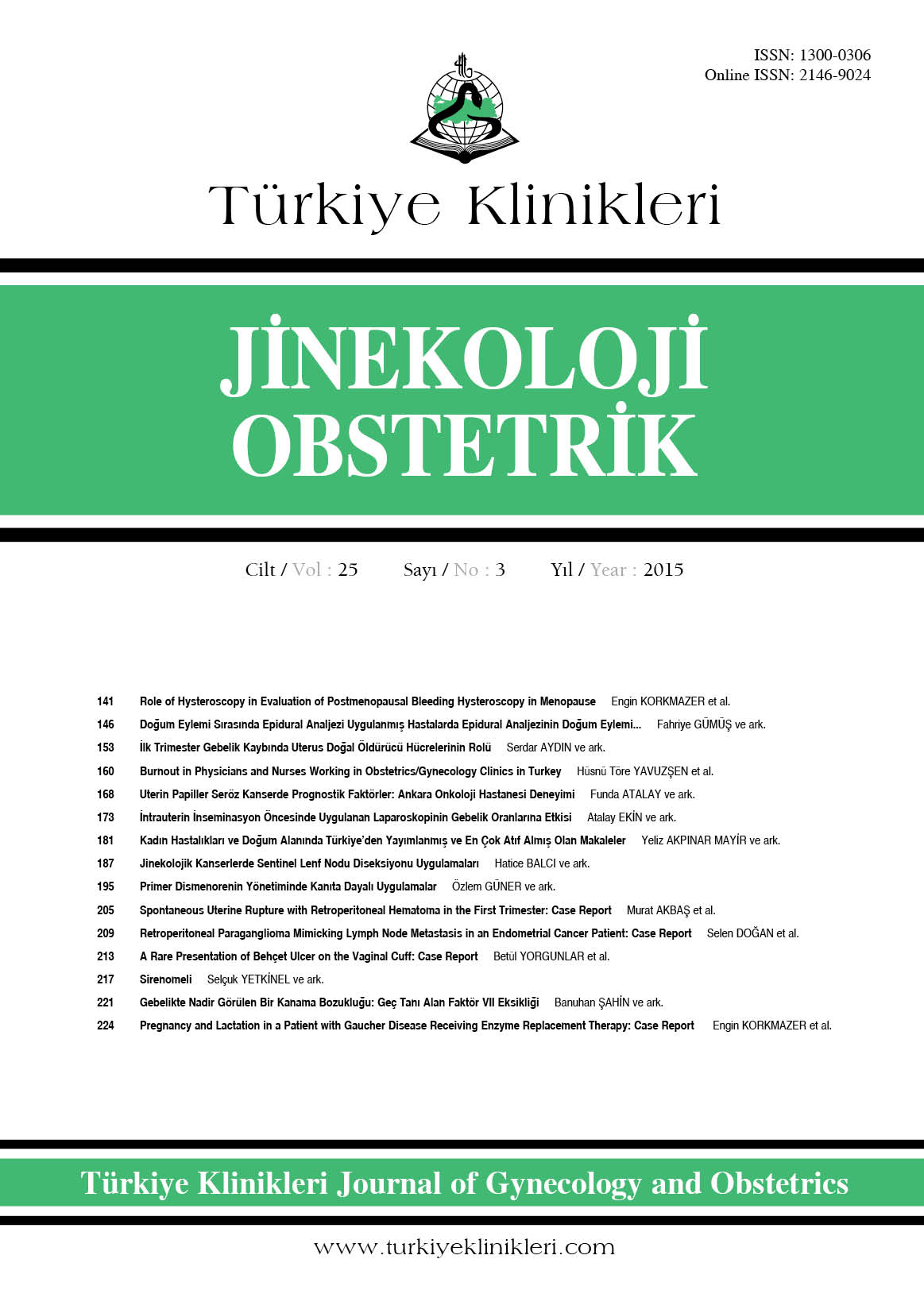Open Access
Peer Reviewed
ORIGINAL RESEARCH
2576 Viewed1351 Downloaded
Role of Hysteroscopy in Evaluation of Postmenopausal Bleeding Hysteroscopy in Menopause
Postmenopozal Kanamanın Değerlendirilmesinde Histeroskopinin Yeri
Turkiye Klinikleri J Gynecol Obst. 2015;25(3):141-5
DOI: 10.5336/gynobstet.2014-42527
Article Language: EN
Article Language: EN
Copyright Ⓒ 2025 by Türkiye Klinikleri. This is an open access article under the CC BY-NC-ND license (http://creativecommons.org/licenses/by-nc-nd/4.0/)
ABSTRACT
Objective: As a possible sign of endometrial cancer postmenopausal bleeding should be evaluated carefully. Dilatation and curettage (D&C) is still gold standard for assessment of postmenopausal bleeding. The development of hysteroscopy has provided a minimally invasive approach for endometrial assessment. We aimed to correlate hysteroscopic impressions and pathological findings in postmenopausal bleeding in this study. Material and Methods: This is a retrospective cross-sectional study. This study involves case records of one hundred thirteen women with postmenopausal bleeding. One hundred thirteen women with postmenopausal bleeding who underwent hysteroscopy with diagnostic D&C between January 2012 and January 2013 at Bursa Zübeyde Hanım Maternity Hospital, Department of Obstetrics and Gynecology. Sensitivity, specificity, positive (PPV) and negative (NPV) predictive values of hysteroscopy were calculated. D&C was set as the ''gold standard''. Results: For the assessment of postmenopausal bleeding hysteroscopy has high sensitivity and specificity for endometrial space occupying lesions (polyp 100%, 93%; fibroid 100%, 91.8%). However for endometrial hyperplasia, hysteroscopy has low sensitivity (75%). Conclusion: Hysteroscopy is a good diagnostic method especially for detecting intrauterine space-occupying (polyp, fibroid) lesions, but moderate for endometrial hyperplasia. Hysteroscopic view combined with hysteroscopy guided endometrial biopsy could be a gold standard for endometrial assessment in postmenopausal bleeding.
Objective: As a possible sign of endometrial cancer postmenopausal bleeding should be evaluated carefully. Dilatation and curettage (D&C) is still gold standard for assessment of postmenopausal bleeding. The development of hysteroscopy has provided a minimally invasive approach for endometrial assessment. We aimed to correlate hysteroscopic impressions and pathological findings in postmenopausal bleeding in this study. Material and Methods: This is a retrospective cross-sectional study. This study involves case records of one hundred thirteen women with postmenopausal bleeding. One hundred thirteen women with postmenopausal bleeding who underwent hysteroscopy with diagnostic D&C between January 2012 and January 2013 at Bursa Zübeyde Hanım Maternity Hospital, Department of Obstetrics and Gynecology. Sensitivity, specificity, positive (PPV) and negative (NPV) predictive values of hysteroscopy were calculated. D&C was set as the ''gold standard''. Results: For the assessment of postmenopausal bleeding hysteroscopy has high sensitivity and specificity for endometrial space occupying lesions (polyp 100%, 93%; fibroid 100%, 91.8%). However for endometrial hyperplasia, hysteroscopy has low sensitivity (75%). Conclusion: Hysteroscopy is a good diagnostic method especially for detecting intrauterine space-occupying (polyp, fibroid) lesions, but moderate for endometrial hyperplasia. Hysteroscopic view combined with hysteroscopy guided endometrial biopsy could be a gold standard for endometrial assessment in postmenopausal bleeding.
ÖZET
Amaç: Postmenopozal kanama endometriyum kanserinin olası bir işareti olması nedenli dikkatli bir şekilde değerlendirilmelidir. Dilatasyon ve Küretaj postmenopozal kanamanın değerlendirilmesinde hâlâ altın standart tanı yöntemidir. Gelişen teknolojiyle birlikte histeroskopi, endometriyal kavitenin değerlendirilmesinde minimal invaziv bir yaklaşım olarak öne çıkmaktadır. Gereç ve Yöntemler: Bu retrospektif, kesitsel bir çalışmadır. Bu çalışmaya postmenopozal kanaması olan yüz on üç kadın dâhil edilmiştir. Bursa Zübeyde Hanım Doğumevi, Kadın Hastalıkları ve Doğum Polikliniğine, Ocak 2012-Ocak 2013 tarihleri arasında postmenopozal kanama nedenli başvuran yüz on üç hastaya histeroskopik gözlemin ardından Dilatasyon ve Küretaj işlemi uygulanmıştır. Dilatasyon ve Küretaj altın standart alınarak, histeroskopinin sensitivite, spesifite, pozitif prediktif değer ve negatif prediktif değerleri hesaplandı. Bulgular: Postmenopozal kanamanın değerlendirilmesinde histeroskopi, intrauterin yer kaplayan lezyonlar için yüksek sensitivite ve spesifiteye sahiptir (polip %100, %93; submüköz miyom %100, %91,8). Buna karşın endometrial hiperplazide histeroskopi düşük sensitiviteye sahiptir (%75). Sonuç: Histeroskopi özellikle intrauterin yer kaplayan lezyonların (polip, submüköz miyom) tanısında iyi bir tanı yöntemiyken aynı başarıyı endometriyal hiperplazide gösterememektedir. Postmenopozal kanamanın değerlendirilmesinde histeroskopik gözlem ve histeroskopi eşliğinde görerek biyopsi altın standart yöntem olacak gibi görünmektedir.
Amaç: Postmenopozal kanama endometriyum kanserinin olası bir işareti olması nedenli dikkatli bir şekilde değerlendirilmelidir. Dilatasyon ve Küretaj postmenopozal kanamanın değerlendirilmesinde hâlâ altın standart tanı yöntemidir. Gelişen teknolojiyle birlikte histeroskopi, endometriyal kavitenin değerlendirilmesinde minimal invaziv bir yaklaşım olarak öne çıkmaktadır. Gereç ve Yöntemler: Bu retrospektif, kesitsel bir çalışmadır. Bu çalışmaya postmenopozal kanaması olan yüz on üç kadın dâhil edilmiştir. Bursa Zübeyde Hanım Doğumevi, Kadın Hastalıkları ve Doğum Polikliniğine, Ocak 2012-Ocak 2013 tarihleri arasında postmenopozal kanama nedenli başvuran yüz on üç hastaya histeroskopik gözlemin ardından Dilatasyon ve Küretaj işlemi uygulanmıştır. Dilatasyon ve Küretaj altın standart alınarak, histeroskopinin sensitivite, spesifite, pozitif prediktif değer ve negatif prediktif değerleri hesaplandı. Bulgular: Postmenopozal kanamanın değerlendirilmesinde histeroskopi, intrauterin yer kaplayan lezyonlar için yüksek sensitivite ve spesifiteye sahiptir (polip %100, %93; submüköz miyom %100, %91,8). Buna karşın endometrial hiperplazide histeroskopi düşük sensitiviteye sahiptir (%75). Sonuç: Histeroskopi özellikle intrauterin yer kaplayan lezyonların (polip, submüköz miyom) tanısında iyi bir tanı yöntemiyken aynı başarıyı endometriyal hiperplazide gösterememektedir. Postmenopozal kanamanın değerlendirilmesinde histeroskopik gözlem ve histeroskopi eşliğinde görerek biyopsi altın standart yöntem olacak gibi görünmektedir.
MENU
POPULAR ARTICLES
MOST DOWNLOADED ARTICLES





This journal is licensed under a Creative Commons Attribution-NonCommercial-NoDerivatives 4.0 International License.










